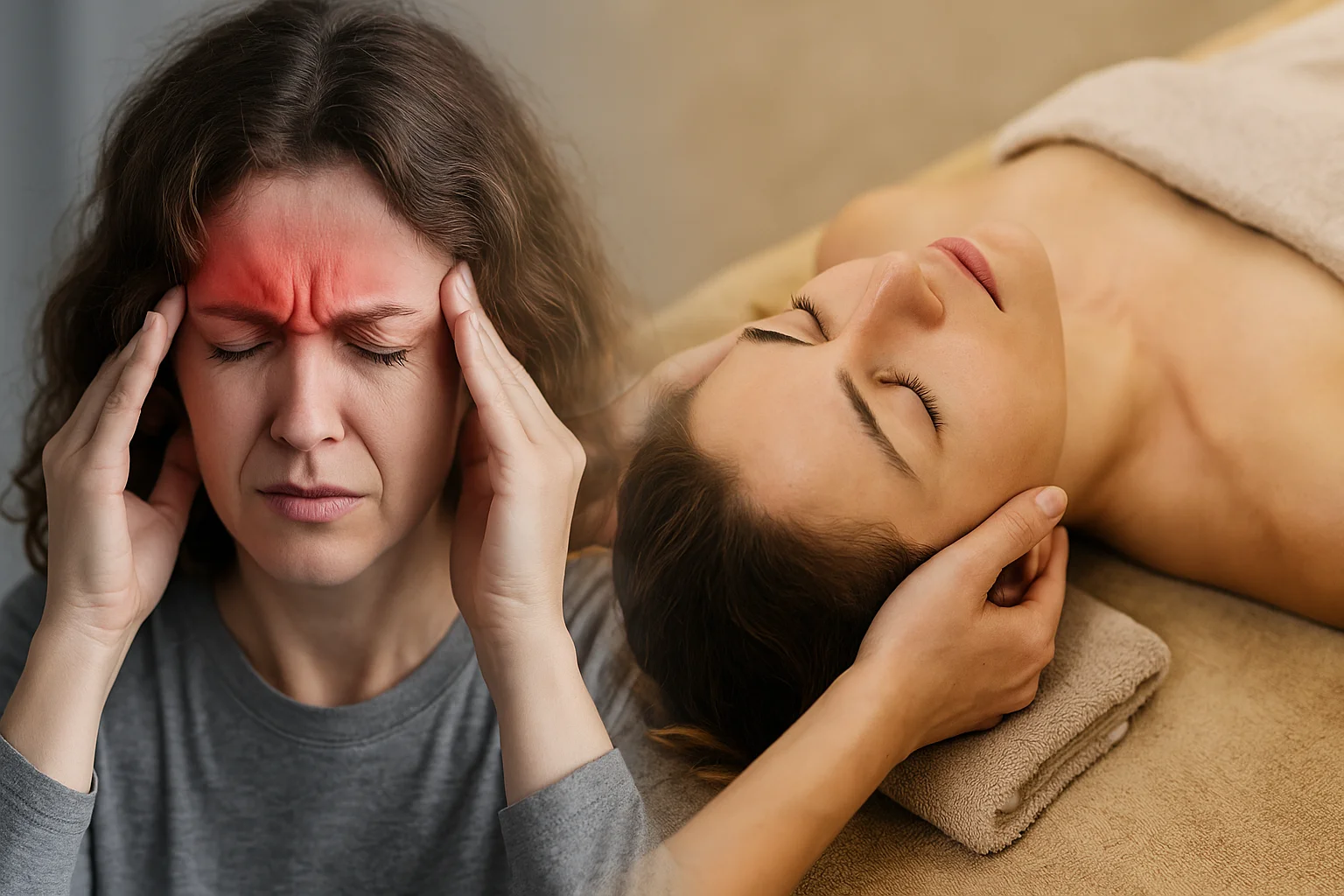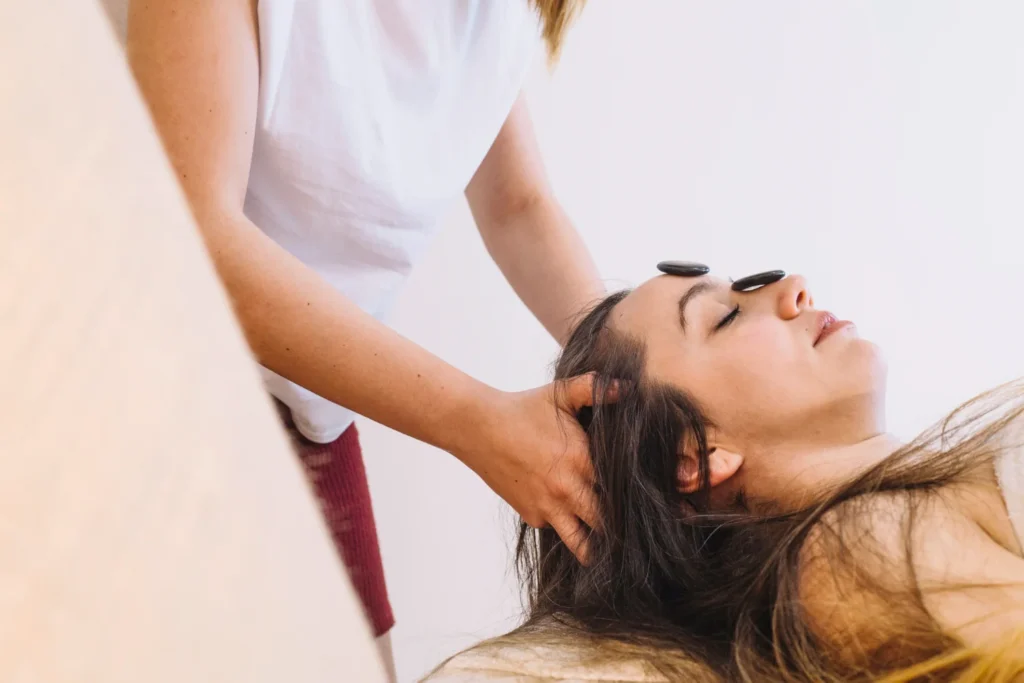If you’ve ever had a migraine, you know it’s not “just a headache.”
It’s the kind of pain that hijacks your day — pounding behind your eyes, making light and sound unbearable, and leaving you desperate for relief. While medication can help, many Canadians are discovering that massage therapy offers a gentler, natural way to manage migraines.
By easing muscle tension, calming your nervous system, and restoring circulation, massage can help prevent migraine flare-ups before they start — and make them less intense when they do. In this guide, we’ll explore how targeted massage techniques can help you take back control of your days, sleep better at night, and reduce the hold migraines have on your life.
The Science Behind Migraines and Muscle Tension
Migraines are complex neurological events that can be influenced by a variety of factors, including muscle tension. Understanding this relationship provides insight into how certain physical manipulations, like massage therapy, can alleviate symptoms. Muscle tightness, particularly in the neck and shoulders, can contribute to the onset and severity of migraine attacks, making it necessary to examine how these elements interact.
Neurological Triggers: Unpacking the Pain
Neurological triggers specific to migraines often include alterations in brain chemistry and blood flow. For some individuals, stress and anxiety produce an uptick in muscle tension, which can create a feedback loop where discomfort leads to more stress, further exacerbating migraine symptoms. This intricate interplay between your body and mind reveals just how critical it is to address both physical and psychological components when managing migraines.
How Muscle Tightness Exacerbates Headaches
Tight muscles in the neck, shoulders, and upper back can amplify the intensity of headache pain, including migraines. When muscle fibres continually contract, they place additional pressure on nerves and blood vessels, potentially triggering a migraine attack or making an existing one far worse. Employing massage therapy can target these areas, facilitating relaxation and improving blood flow, ultimately serving to alleviate the pain caused by muscle tension.
The connection between muscle tightness and migraines can often be underscored by sheer numbers; studies suggest that over 75% of migraine sufferers report neck tension prior to an attack. This muscle tension can lead to referred pain, where discomfort radiates from the neck into the head. Techniques such as deep tissue massage focus on breaking down these tight muscle knots, allowing for greater mobility and reduced pain levels. Addressing this layer of discomfort is often the key to not only managing but potentially reducing the frequency of migraine episodes.
The Role of Massage Therapy in Migraine Management

Massage therapy has emerged as a valuable tool in the fight against migraines, offering a holistic approach that complements traditional treatments. By targeting muscle tension, emotional stress, and overall relaxation, massage can provide significant relief for migraine sufferers. You may find that regular sessions can decrease both the frequency and intensity of your migraines, allowing you to regain control over your life.
Mechanisms of Relief: Circulation and Endorphins
Massage therapy enhances circulation, allowing more oxygen and nutrients to reach your muscles and tissues. This increased blood flow can lead to reduced muscle tightness and inflammation, factors often associated with migraines. Additionally, massage triggers the release of endorphins, your body’s natural painkillers, which can help alleviate pain and promote a sense of well-being, leaving you feeling more at ease.
Types of Massage Techniques Beneficial for Migraines
Several massage techniques can effectively target migraine symptoms. Techniques such as Swedish, trigger point therapy, and deep tissue massage each have distinct benefits that cater to your specific needs. For instance, Swedish massage focuses on relaxation, while trigger point therapy targets specific areas of tension. Deep tissue massage can release chronic knots, providing substantial relief. By working with a qualified therapist, you can explore which methods work best for your condition.
- Swedish massage: Promotes relaxation and eases tension.
- Trigger point therapy: Targets specific pain points for relief.
- Deep tissue massage: Addresses chronic muscle tightness.
- Aromatherapy massage: Incorporates vital oils for added benefits.
- Shiatsu: Balances energy flow and promotes overall wellness. Assume that you try a combination of these techniques for optimal results.
| Type of Massage | Benefits |
| Swedish | Enhances relaxation and reduces stress. |
| Trigger Point | Relieves specific pain areas and muscle knots. |
| Deep Tissue | Releases chronic muscle tension and improves mobility. |
| Aromatherapy | Enhances relaxation through vital oils. |
| Shiatsu | Promotes energy balance and restores overall wellness. |
Exploring various massage techniques can offer insights into what best alleviates your migraine symptoms. By discussing your migraine history and symptoms with a licensed massage therapist, you can customize your sessions for maximum effectiveness.
- Communicate openly about your migraine triggers and symptoms.
- Ask for specific techniques that align with your needs.
- Consider frequency; regular sessions can yield long-term benefits.
- Incorporate self-massage techniques at home for additional relief.
- Keep track of your migraine patterns to share with your therapist. Assume that finding a suitable method might take time but can be rewarding.
| Recommendation | Description |
| Regular sessions | Consistency can lead to cumulative benefits. |
| Self-massage techniques | Convenient ways to manage minor symptoms at home. |
| Integration with other therapies | Combining massage with physical therapy or acupuncture may optimize relief. |
| Keeping a migraine diary | Documenting your triggers helps identify patterns for better treatment. |
| Consulting your healthcare provider | Ensure you’re considering all options available for migraine management. |
Practical Steps for Incorporating Massage Therapy
Integrating massage therapy into your migraine management routine can be both effective and enjoyable. Start by setting aside specific times each week dedicated solely to receiving massage therapy, which can help establish a consistent practice. Consider varying the techniques, such as Swedish, deep tissue, or trigger point therapy to determine what works best for your symptoms. Communicate openly with your massage therapist about your migraine triggers, pain areas, and any other health concerns to tailor your sessions for optimal benefit.
Finding Qualified Practitioners: What to Look For
Choose licensed massage therapists with specialized training in headache and migraine treatment. Look for practitioners who are members of professional organizations, such as the American Massage Therapy Association (AMTA) or the Associated Bodywork & Massage Professionals (ABMP). Read reviews and ask for recommendations from healthcare providers or fellow migraine sufferers to ensure you find someone well-versed in using massage therapy for migraine relief.
Frequency and Timing: Optimizing Benefits
Establishing the right frequency and timing for your massage sessions can significantly enhance their benefits in managing migraines. Ideally, scheduling appointments once or twice a week can help relieve muscle tension and stress, leading to more consistent symptom relief. Additionally, timing your massage before known headache triggers, such as a stressful event, can be especially advantageous in preventing an attack.
Consider keeping a migraine diary to track how often you get massages and the impact on your migraine frequency and severity. Over time, this log will provide valuable insights and help you adjust the timing or frequency of your sessions as needed. For some individuals, weekly sessions may be sufficient, while others might benefit from more frequent treatments. Allow your body’s response to guide you, adapting as necessary while remaining committed to the practice.
Complementary Therapies to Enhance Massage Efficacy
Integrating complementary therapies alongside massage can significantly amplify the benefits you receive from your sessions. Techniques such as acupuncture, yoga, and lifestyle modifications can work synergistically, addressing both the physical and mental aspects of migraine management. By combining these modalities, you create a holistic approach that not only alleviates tension but also fosters overall well-being, potentially reducing the frequency and intensity of your migraines.
Marrying Massage with Acupuncture and Yoga
The fusion of massage therapy with acupuncture and yoga can provide a multifaceted approach to migraine relief. Acupuncture specifically targets key pressure points that correspond to headache relief, while massage works on muscle tension. Yoga contributes by enhancing flexibility and promoting relaxation, creating a comprehensive treatment plan that empowers you to manage migraines more effectively and regain control over your health.
Lifestyle Adjustments: Diet and Hydration
Diet and hydration play pivotal roles in migraine management. Maintaining a balanced diet rich in fruits, vegetables, lean proteins, and whole grains can help regulate blood sugar levels, reducing the likelihood of migraine triggers. Staying well-hydrated is equally important, as dehydration is known to be a common precursor to headaches. Incorporating magnesium-rich foods like nuts and leafy greens into your meals can also aid in reducing the frequency of migraines.
Optimizing your diet involves tracking your food intake and identifying potential triggers. Many migraine sufferers benefit from avoiding aged cheeses, processed meats, and excessive caffeine. Paying attention to your hydration levels is equally necessary. Aiming for at least eight glasses of water per day can mitigate dehydration. Additionally, electrolyte-rich options, such as coconut water, can replenish lost minerals and further support your overall migraine management strategy. By focusing on these lifestyle adjustments, you cultivate a foundation for better health and potentially fewer migraine episodes.
Expert Insights: Perspectives from Therapists and Patients
Therapists emphasize the benefits of integrating massage therapy into your migraine management plan, noting that personalized techniques foster relaxation and reduce muscle tension. Many share anecdotes of patients who experienced fewer migraine episodes following consistent massage sessions. Patient testimonials further support these claims, showcasing improved quality of life and enhanced coping mechanisms through targeted massage therapy.
Success Stories: Real-Life Transformations
Patients often recount transformative journeys, where regular massage therapy not only alleviated their migraine symptoms but also empowered them to reclaim daily activities. One individual, after several weeks of targeted sessions, reported a significant reduction in migraine frequency and severity. The healing touch of massage helped foster a deeper connection between body awareness and emotional well-being, leading to remarkable lifestyle improvements.
Common Misconceptions and Cautions in Treatment
Dispelling myths is necessary when considering massage therapy for migraines. One common misconception is that all massages are beneficial for all types of headaches. However, not every technique is suitable for migraine relief. Additionally, some individuals may experience tenderness or soreness after a deep tissue massage, which can be misinterpreted as an exacerbation of symptoms. It’s advisable to consult with a qualified therapist who understands your specific condition to tailor an approach that’s safe and effective.
Addressing misconceptions ensures that you approach massage therapy with realistic expectations. For instance, many believe that aggressive massage techniques will always provide immediate relief; however, gentle, targeted methods can often yield better long-term results without aggravating your symptoms. Additionally, recognizing that certain pressure points may trigger discomfort in some individuals is vital. Open communication with your therapist about your migraine history and preferences will enhance the effectiveness of your treatments while minimizing potential negative experiences.
Managing Migraines with Massage Therapy Conclusion
So, incorporating massage therapy into your migraine management routine can provide significant relief and enhance your overall well-being. By targeting specific muscle groups and reducing tension, you can help alleviate the intensity and frequency of your migraines. Consider seeking a qualified therapist who understands your specific needs and preferences. With consistent practice, you may find that massage therapy contributes positively to your quality of life, allowing you to better navigate the challenges of migraines.
